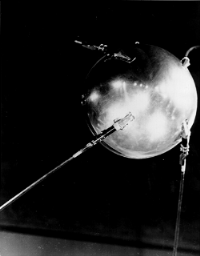Sputnik 1 Sputnik 1 was launched from the Baikonur Cosmodrome on October 4, 1957. The satellite was an aluminum sphere 58 cm (about 22.5 inches) in diameter. It sported four whip-like antennas that were about 2.5 m (8 feet) long. The satellite transmitted data about the density of the upper layers of the atmosphere and the propagation of radio signals in the ionosphere. The instruments and electric power sources were housed in a sealed capsule and included transmitters operated at 20.005 and 40.002 MHz, the emissions taking place in alternating groups of 0.3 s in duration. The downlink telemetry also included data on temperatures inside and on the surface of the sphere. Sputnik 1 was launched from the Baikonur Cosmodrome on October 4, 1957. The satellite was an aluminum sphere 58 cm (about 22.5 inches) in diameter. It sported four whip-like antennas that were about 2.5 m (8 feet) long. The satellite transmitted data about the density of the upper layers of the atmosphere and the propagation of radio signals in the ionosphere. The instruments and electric power sources were housed in a sealed capsule and included transmitters operated at 20.005 and 40.002 MHz, the emissions taking place in alternating groups of 0.3 s in duration. The downlink telemetry also included data on temperatures inside and on the surface of the sphere.
The satellite’s transmitters operated for three weeks, until the on-board chemical batteries failed, and were monitored with intense interest around the world. The orbit of the then inactive satellite decayed 92 days after launch (on January 4, 1958) after the satellite had completed about 1400 orbits of the Earth traveling about 70 million kilometers (about 44 million miles). The orbital apogee declined from 947 km (about 588 miles) after launch to 600 km (about 375 miles) by Dec. 9th. The Sputnik 1 rocket booster also reached Earth orbit and was visible from the ground at night as a first magnitude object, while the satellite itself, although highly polished, was barely visible at sixth magnitude. References:
|